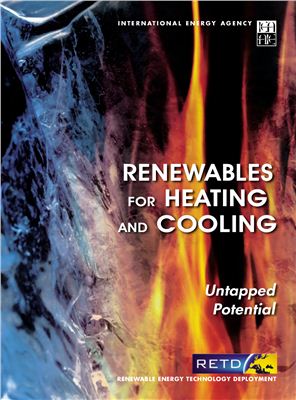Язык - английчкий,
количество страниц - 210
2007 г.
The use of renewable energy systems for both domestic and industrial heating and cooling applications has received relatively little attention compared with renewable electricity or transport biofuels. Where a good biomass, geothermal or solar thermal resource exists, heating technologies can often be competitive with those using fossil fuels. In a few countries their natural deployment
has occurred with little if any policy support, resulting in greenhouse gas reductions. Elsewhere, several of the few national policies in place to remove barriers and encourage the greater deployment of renewable heat, (such as from using wood-buing boilers, geothermal ground-heat pumps, and solar water heaters) have proved to be cost-effective, yet other countries have been slow to replicate them. In regions where cooling has a greater energy demand than heating, especially during peak summer periods, renewable energy cooling systems show good potential for further development.
This timely report examines the technologies, current markets and relative costs for heat and cold production using biomass, geothermal and solar-assisted systems. It evaluates a range of national case studies and relevant policies. Should the successful and more cost-effective policies be implemented by other countries, then the relatively untapped economic potential of renewable
energy heating and cooling systems could be better realised, resulting in potential doubling of the present market within the next few years.
количество страниц - 210
2007 г.
The use of renewable energy systems for both domestic and industrial heating and cooling applications has received relatively little attention compared with renewable electricity or transport biofuels. Where a good biomass, geothermal or solar thermal resource exists, heating technologies can often be competitive with those using fossil fuels. In a few countries their natural deployment
has occurred with little if any policy support, resulting in greenhouse gas reductions. Elsewhere, several of the few national policies in place to remove barriers and encourage the greater deployment of renewable heat, (such as from using wood-buing boilers, geothermal ground-heat pumps, and solar water heaters) have proved to be cost-effective, yet other countries have been slow to replicate them. In regions where cooling has a greater energy demand than heating, especially during peak summer periods, renewable energy cooling systems show good potential for further development.
This timely report examines the technologies, current markets and relative costs for heat and cold production using biomass, geothermal and solar-assisted systems. It evaluates a range of national case studies and relevant policies. Should the successful and more cost-effective policies be implemented by other countries, then the relatively untapped economic potential of renewable
energy heating and cooling systems could be better realised, resulting in potential doubling of the present market within the next few years.

